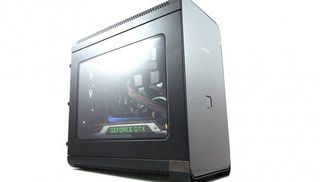Build your own Steam Machine

Everything you know about the PC gaming world is set to change over the next twelve months. We're going to experience a tectonic shift in the coming year on a scale not seen since the introduction of Windows 95 and the death of DOS. Valve have struck a blow for open-source gaming must have reverberated around the corridors of Microsoft's Redmond HQ like the last peal at a funeral.
Okay, that's overselling it a bit, but the groundswell of support surrounding Linux as a viable gaming OS alternative to Windows, currently spearheaded by Valve, really could change things. We'll at least get a range of gaming PCs that look like nothing on the market right now. Next year Valve have announced that they will be helping hardware partners sell branded Steam Machines specifically designed to run with a bespoke Linux-based OS and sit under your TV in the living room. One of the advantages they'll have over the consoles is that they'll be modular and upgradeable, and rely on the hardware we use to power our desktops right now.
That means we'll be able to build our own Steam Machines to fit our living rooms. With that in mind, I've scoured the world of small form-factor hardware to create two sample Steam machines, a no-holds barred powerhouse and a powerful but more sensibly priced offering.
Valve have admitted their prototype is going to be “something special”, a high-performance beast of a mini-rig. But have also not discouraged others from building their own. “Apart from the custom enclosure,” Valve says about the Steam Machines, “anyone can go and build exactly the same machine by shopping for components and assembling it themselves. And we expect that at least a few people will do just that.” The only thing we're missing right now is the SteamOS itself. But I'm betting it will be entering beta in more than just the 300 prototype machines when they eventually ship.
The biggest gaming news, reviews and hardware deals
Keep up to date with the most important stories and the best deals, as picked by the PC Gamer team.

Dave has been gaming since the days of Zaxxon and Lady Bug on the Colecovision, and code books for the Commodore Vic 20 (Death Race 2000!). He built his first gaming PC at the tender age of 16, and finally finished bug-fixing the Cyrix-based system around a year later. When he dropped it out of the window. He first started writing for Official PlayStation Magazine and Xbox World many decades ago, then moved onto PC Format full-time, then PC Gamer, TechRadar, and T3 among others. Now he's back, writing about the nightmarish graphics card market, CPUs with more cores than sense, gaming laptops hotter than the sun, and SSDs more capacious than a Cybertruck.
Most Popular



